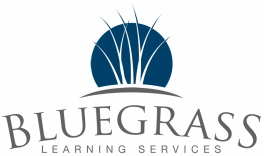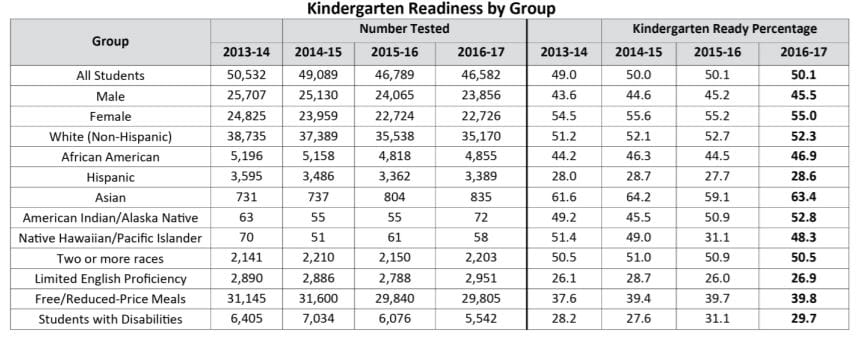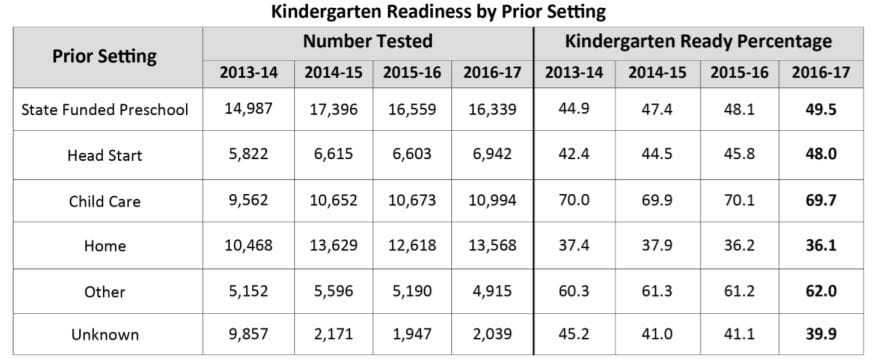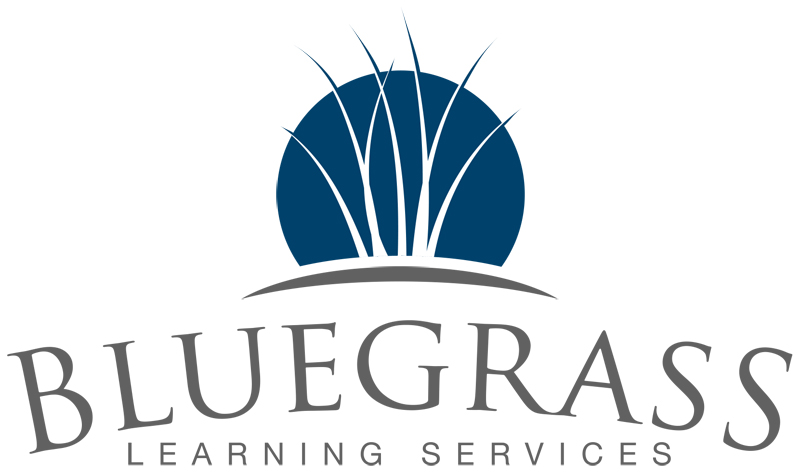
The data shows we have much work to do in the Commonwealth.
There are some bright spots in the data.
The number of African American children ‘ready for kindergarten’ increased from 44.5% in 2015 to 46.9% this year. It’s easy to lose perspective when looking at percentages. Here's what the numbers mean.
In the fall of last year, 2,144 African American children in Kentucky arrived to their first day of school ‘ready’ for kindergarten. 2,711 were ‘not ready.
This year, 2,277 African American children in Kentucky were ‘ready for kindergarten.’ 2.578 were not. 133 additional students were well prepared to enter school.
If you are wondering why these numbers are important, picture those 133 kids. They have a much better chance of success, not just in school but throughout life, because they entered school ready to learn. They will get better grades and are less likely to have behavior problems. They will be better adjusted socially and are less likely to experience mental health issues later in life. They are more likely to get into college. They will get better jobs, pay more taxes and be more involved in their communities than those children who show up to school ‘not ready.’
Research tells us those 133 kids will grow up healthier, happier and more productive citizens of Kentucky because they arrived at school ‘ready for kindergarten.’
One big question remains: If this is so important, why aren’t we improving at a faster rate? No growth in the ‘all students’ category over three years should be unacceptable.
I spend a lot of time around educators. I hire them exclusively (all my employees are current or retired teachers) and many of our customers are school administrators. If you ask educators to define the problem, you will likely hear some version of ‘It’s the parents fault.’ They may be a little more diplomatic, but the underlying sentiment will be there. Very few will say “Our district is not doing a good job of supporting families.”

Therein lies the problem. Two groups of people (our schools and the family) have a shared responsibility for a child’s development and educational achievement. Instead of working well together, they often place blame on the other party.
If we are honest about it, the truth lies somewhere in the middle. Some parents could make a better effort to work with the school. Most schools could do a better job of supporting families. I’m sure that statement will upset some people, but that’s OK. It might be time for a few of us to get upset.
Playing the blame game has led to three years of zero growth in our kindergarten readiness numbers. The time for blaming is over. Now we need to reconsider our attitudes and approaches and try to find solutions.
Take a look at the K-Ready results based on prior setting.
Children who stay at home prior to entering school, meaning they didn’t attend head start, preschool or go to private daycare, are the lowest performing group by prior setting. Nearly 2 out of 3 kids who 'stayed at home' are unprepared for kindergarten. 36.1% 'ready' is the lowest percentage in the last four years. We are moving in the wrong direction.
Private groups in Kentucky are trying to address this issue. The United Way, with funding assistance from Toyota and other sponsors, should be commended for their Born Learning programs.
Are they showing success? I would guess they are, but It’s tough to determine by only looking at the information publicly available on their website. The only case study they provide is a little old (downloadable file linked at bottom of this page) and most of the data is related to parent perceptions about the program, not hard data on how many students they have helped become ‘kindergarten ready.’
If we can get better data showing effectiveness, the state may want to consider helping schools exand the program.
The United Way and Toyota are not the only people trying to help. Our public school and Head Start leaders are clamoring for more funding so they can serve more students. I don’t know enough about KY’s budget situation to say if it’s feasible. I’ll leave that up to the policy makers in Frankfort to decide.
I do know the return on investment for high quality preschool programs is substantial. Legislators should consider that when determining budgets.
While additional funding could help, school administrators waiting around for that to happen are making a mistake. We need to do a better job of supporting those ‘home’ children today, and not wait on private foundations or Frankfort to step up with funding.
Even if funding increases, the question of making universal preschool mandatory is controversial. Many families will prefer to keep their children at home until kindergarten and they should have that option.

Some districts have considered, or are trying:
Home visits: Well-designed programs are highly effective for families who receive multiple support visits over time. One or two visits just before school begins isn’t going to produce results. The biggest roadblock to implementing an effective program is cost. It’s a long-term solution with a high chance of success, but it will require a big financial commitment, from private, local, state and federal funding sources.
Kindergarten boot camps (where kids come to school 1-2 weeks over the summer): It can help a child with the social and emotional aspects of the first day of school, but it doesn’t do much for their academic and cognitive preparedness or physical development. If the family hasn’t supported the development of language skills in the last 5 years, 1-2 weeks may help the child get comfortable with school routines, but it isn’t going to help with overall readiness.
Parent Universities and Family Nights can be beneficial, especially if they are ongoing and not just a one-time event. The biggest issue is getting enough parents to participate over multiple sessions.
Schools love to hold in-person events, but many parents choose not to participate. I’ve heard school administrators say ‘the best form of parent engagement is in-person and face-to-face.’ That sounds great in theory.
In my opinion, assuming all parents want to engage in the exact same way is a huge mistake. When districts insist on only providing face-to face meeting opportunities, they are trying to force all parents into the same box.
Our interviews with parents have shown many are not interested in attending events at school, even when those events address issues they care about deeply. Families want to learn how they can help their child. For a variety of reasons, many parents do not want to come to an event.
I sit on an advisory council for a middle school’s Youth Service Center here in Kentucky. At the beginning of the year, the coordinator sent a survey home to more than 600 parents. They were asked to identify issues their child needed help with the most. Over 500 families responded.
Top 3 things parents said their teen needed help with:
- Job and employment training
- Self-esteem
- Fitting in
The next question asked parents to identify health issues that interfere with their child’s learning.
The top three answers were:
- Sleep
- Nutrition
- Mental health issues
None of this is surprising considering we are talking about 7th and 8th graders. Here is what is surprising: The next question asked parents if they are interested in attending a learning event at school about any of the topics. Only 31% answered ‘yes.’
This is a high achieving school, with few children living in poverty. The responding parents are engaged in their child’s lives and care deeply about education. I would venture to guess there aren’t many schools in Kentucky with more concerned and engaged parents. They identify issues they are deeply concerned about, yet almost 70% say they are unwilling to come to a school event to learn more about that topic.
Think about that for a second. Engaged parents, at a high achieving school, said they have no desire to get help by attending an event at school. They would prefer to figure it out on their own, or access self-help information.
When schools take a position that requires families to only get support at in-person events, they are choosing not to serve many families. Some recent research highlights this point.
‘The Execution Trap,’ from the July 2010 issue of the Harvard Business Review (HBR), talks about how businesses communicate with customers. It’s relevant for school administrators who are trying to engage families.
The article talks about a bank that tried to force their tellers to interact with each customer in the exact same way. They revised the policy after noticing their highest performing tellers were ignoring it. Instead, they were treating different types of customers in a different way, based on the needs of the individual.
Here’s a quote from another article found on the HBR website:
“Most customers these days demonstrate a huge — and increasing — appetite for self-service, yet most companies run their operations as if customers prefer to interact with them live.
In our research on this topic (HBR article “Stop Trying to Delight Your Customers“), we’ve found that corporate leaders dramatically overestimate the extent to which their customers actually want to talk to them.”
Administrators must acknowledge some parents are not interested in attending events, and begin offering support to those families.

San Francisco Unified School District has a text message program for preschool parents. Parents sign up and get frequent messages telling them what they can do to help their child prepare for school. After six years, the results are promising.
The Ohio Department of Education has a similar system, but I signed up 3 months ago and have only received one text message in that time. They’ve either abandoned the system, or they recognized I’m a Kentuckian and removed me from the mailing list.
A study by Matthew Kraft, of Brown University and Todd Rogers, of the Harvard Kennedy School of Government, looked at the effectiveness of frequently emailing parents (link to working paper, full study can be found here). It showed how frequent, light-touch communications can change parent behavior and improve student-parent interactions. The study looked at parents with children in high school, but the lessons learned could be applied to preschool families.
My team and I continue to work on this as well. We have been building Family Five for the last two years. It’s a series of short videos, in English and Spanish, that show parents simple, at-home learning activities they can use to prepare their child for kindergarten.
While I wish we could say Family Five is a silver bullet, it’s not. Producing great content for families is half the battle. Schools then need to develop and execute a plan to reach all families. They must identify those parents who do not have children enrolled in district preschool programs, and be willing to support those who have shown they aren’t interested in attending in-person events.
Tips for school administrators:
- Stomp out, with reckless abandon, the 'parents just don't care' attitude in your school. After conducting hundreds of parent interviews over the last 2 years, I can tell you nothing is further from the truth. Your ‘tough to reach’ families may not want to engage with you in the ways you’ve tried, but they do care about their children and desperately want to see them do well in school. You just need to figure out how to reach them.
- Recognize your K-Ready numbers won’t drastically improve until you engage all families, even those not in district preschool programs.
- Identify those families, by any and all means, and capture their contact information:
- Sign-up forms on your website
- Sign up forms at front desk of each school (and train front office staff so they can explain why they are getting the information).
- Ask your community partners (libraries, housing authorities, churches, etc.) to help you gather parent contact information from families they serve.
- Once you have a list, invite families to your parent learning events…but don’t forget to,
- Develop a plan to support those families who choose not to attend in-person events (there will be many).
- What content will you share? Create your own or use a third-party solution.
- How often will you share tips? To have a big impact it needs to be frequent and ongoing (i.e. one tip a week for a year). A single, large tip sheet (with everything a parent needs to know) is overwhelming. Break the content into bite-sized chunks and share frequently.
- What channels will you use to communicate? (offer more than one option so parents have a choice)
- Text message
- District email/messaging/phone call system (some will allow you to set up a group for ‘preschool parents’ and send frequent tips)
- Posting on district website or social media (This is the easiest to implement, but the worst option. Our research indicates you will get low participation by posting and hoping families find it. For the biggest impact, the message needs to come directly to each parent).
- Share actionable tips parents can use immediately.
Finally, we need to come up with a meaningful way to measure effectiveness. Few districts and schools quantify their parent engagement efforts. That makes it tough to determine if programs are successful.
Houston ISD in Texas is one district doing it well. Their Family and Community Engagement Department submits an annual report to the board. The report includes data on:
- how many family members attended learning events
- how many students those parents represent
- the grade levels of those children
- how those children perform in relation to other students
A school’s report could look like this: 50 parents participated in our text messaging program last year. Those parents had 44 children entering kindergarten. 64% of those children were designated ‘ready for kindergarten.' Of the children who did not have a parent participate in the texting program, only 48% were ‘ready.’
When we ask school and district leaders how many families attended their last parent event, we get answers like, “It was a decent turnout, we had around 100 people here.” They are rarely able to provide an exact number, give a breakdown of attendees (how many teachers, parents, kids, etc.), or tell us how those children are performing compared to students whose parents didn't attend.
Capturing good data will require planning on the part of our school leaders, but it will help them determine what is working and what isn’t.
The time for blaming parents, schools or the funding situation is over. Now it's time to find new ways to support all families.
If we can't make it happen, I'm afraid three years from now we will still be reading that half of Kentucky children are entering school unprepared.
Author
Joe Deaton is Founder and President of Bluegrass Learning.



 RSS Feed
RSS Feed
